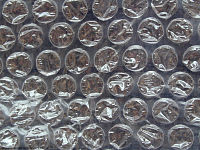Bubble wrap: Difference between revisions
Fllmtlchcb (talk | contribs) Undid revision 242989535 by 71.126.82.54 (talk) |
|||
| Line 22: | Line 22: | ||
== References == |
== References == |
||
* Brody, A. L., and Marsh, K, S., "Encyclopedia of Packaging Technology", John Wiley & Sons, 1997, ISBN 0-471-06397-5 |
* Brody, A. L., and Marsh, K, S., "Encyclopedia of Packaging Technology", John Wiley & Sons, 1997, ISBN 0-471-06397-5 |
||
i hate bubble wrap but i love the jonas brothers |
|||
==See also== |
==See also== |
||
Revision as of 17:04, 4 October 2008
| Bubble Wrap Logo | |
 | |
| Owner | Sealed Air Corporation |
|---|---|
| Country | |
| Markets | world |
| Website | http://www.bubblewrap.com/ |
Bubble Wrap is a pliable transparent plastic material commonly used for packing fragile items. Regularly spaced, protruding air-filled hemispheres ("bubbles") provide cushioning for precious or breakable items. Bubble Wrap was created by two engineers, Alfred Fielding and Marc Chavannes, in 1957.
Like many innovations, it was accidental: Fielding and Chavannes were trying to create a textured plastic wallpaper with paper backing that could be easily cleaned. The term is a registered trademark of the Sealed Air Corporation (US) which was founded in 1960 by those inventors, and should theoretically only be used for products of that company. The bubbles that provide the cushioning for fragile or sensitive objects are generally available in different sizes, depending on the size of the object being packed, as well as the level of cushioning protection that is needed. Multiple layers might be needed to provide shock protection while a single layer might be used for a surface protective layer. They can be as small as 1/4 inch (6 millimeters) in diameter, to as large as an inch (25 millimeters) or more, to provide added levels of shock absorption during transit. In addition to the degree of protection available from the size of the air bubbles in the plastic, the plastic material itself can offer some forms of protection for the object in question. For example, when shipping sensitive electronic parts and components, a type of Bubble Wrap is used that employs an anti-static plastic that dissipates static charges, thereby protecting the sensitive electronic chips from static which can damage them.
Aside from its commercial use as a shock absorption technique, Bubble Wrap has developed a second use as a sort of stress relief: after opening the package in which the Bubble Wrap is used, popping the bubbles has been seen to have a cathartic effect on people. Whether for stress relief or simple idle occupation of one's fingers, or for the amusement of children, the action of the popping, as well as the tactile response and associated noise made, is a widely known and widely used distraction and source of amusement, to the point that a virtual version of bubble wrap for popping has been created.
References
- Brody, A. L., and Marsh, K, S., "Encyclopedia of Packaging Technology", John Wiley & Sons, 1997, ISBN 0-471-06397-5
